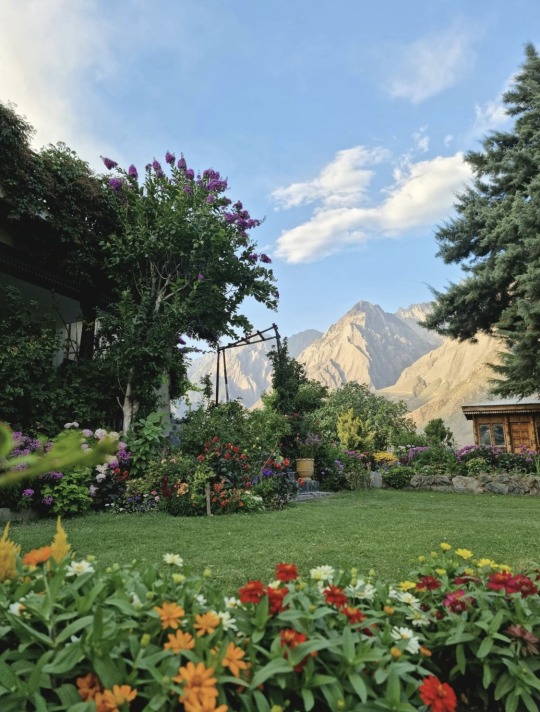#chitral
Text

The white domes of Chitral Mosque point upward to the 25,289' summit of Tirich Mir, the highest mountain in Pakistan's Hindu Kush Range, some 50 miles in the distance.
Ric Ergenbright
5K notes
·
View notes
Text
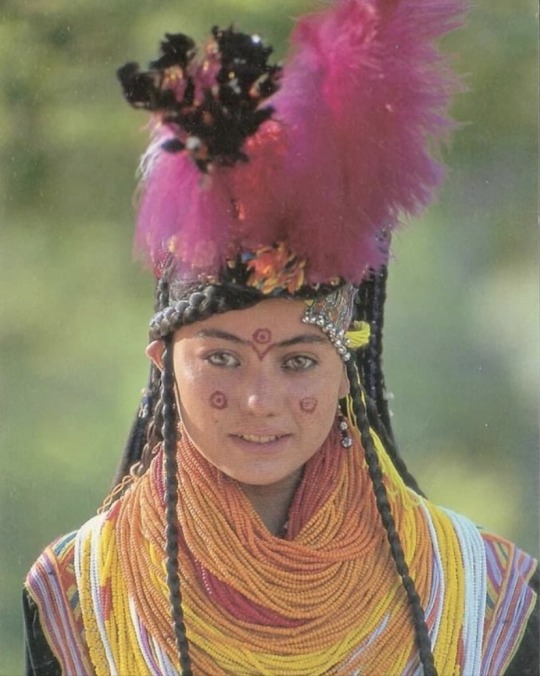
A postcard of a Kalash girl c.1960s-1980s
83 notes
·
View notes
Note
i saw the tags you put on the mongolian tea video and i'm mega intrigued (i love hearing about food from other cultures!!): googling rondijzhu yields no results, and laghman comes up as a type of noodle dish? would you mind talking a bit abt the breakfast from chitral? :D
@albertinesimonet I'm so, so, so sorry for how long it's taken me to answer this 😭 University's been hell, I really want to give this answer the detail it deserves, so I hope you can forgive the fact that it's, like, a month late.
Anyway! I'm so happy someone on Tumblr's taken interest in my tiny river-valley hometown! This entire answer is going to function as me gushing about it now lol. Some context on what I'm about to say is that while Chitral is in Pakistan, it's in the far, far north of it, bordering the Tajik-majority area of Afghanistan and very, very close to Tajikistan. So while Chitral is, through borders, considered part of South Asia, its culture and cuisine is much more similar to more Central Asian ones.

(There's Chitral on a map of Pakistan!)
Another thing worth mentioning is that 'Chitral' itself is a bit of a catch-all term for the general part of Pakistan that speaks a language called 'Khowar' and its dialects, not taking into account the fact that the cultures within the Chitral district vary wildly based on where exactly in the mountains you are. Just saying that so you know to take what I say with a grain of salt, and just know that it's applicable to a specific part in this specific region of the district (think somewhere in the green portion on the map below).

With that said, breakfast in Chitral can be anything, as long as it's hearty! People generally don't have a solid 'lunch', as midday is the best time to get outdoor work done, so big breakfasts are the norm. In summer, it's butter tea (tea with butter and salt boiled into the milk) with dried fruits (I'm a fan of apricots, but dried grapes, peaches and assorted berries are common too) and Chitrali bread (which is very, very thick; I think some people call it tikki but we've just always called it 'Chitrali bread' lol), usually with cottage cheese. You can stuff the Chitrali bread with minced meat (goat or lamb, mostly), cottage cheese or milk curds too!
Winter, though, is where breakfast becomes key, and which is where the foods you asked about come in– in summer, at least, the weather is better so you do have time to eat in the afternoon, but in winter? No chance. In Chitral, winter breakfasts are massive, warm and hearty as hell. Salty butter tea is still a must, coupled with Chitrali bread which, in winter, is usually stuffed. A lot of people choose to add milk curds into the tea, but I never liked doing that, so. Rip.
Other people add dried rondijzhu (which is a very, very rough Anglicisation of a Khowar word so I'm not surprised nothing came up when you Googled it!) to their tea too. Rondijzhu, which is also served generally at breakfast in the winters, is basically just portions of spit-roasted lamb or goat that are really, really heavily salted (Chitral isn't the place to go if you have cholesterol issues) to make sure they last. A lot of people take aside parts of the freshly spit-roasted meat to slice it up into little chunks and dry it seperately to the rest of the rondijzhu, so they can use it as stuffing, in tea, in mantu (steamed dumplings– pretty similar to Chinese bao!), et cetera.
Another use for rondijzhu, and a way to heat it up for breakfast, is by boiling it with khalli, or laghman (they're both the same thing– we call it laghman but I know people in the vicinity of Chitral city call it khalli). It is indeed a type of noodle dish! It's basically just soft wheat noodle soup cooked with usually either minced meat or chunks of mutton or beef and a shitton of herbs. It's more on the brothy side, and so is super warming, especially when served alongside Chitrali bread. Something people (or, at least, we) tend to do is, when boiling the wheat noodles that were cut the night before for the morning laghman, adding rondijzhu to the noodles. This both warms up the rondijzhu and acts kind-of like stock for the laghman broth. You can take the rondijzhu out and eat is seperately, or keep it in the laghman, your choice (I personally prefer having it seperately, but I'm a picky eater by mountain village standards).
That said, laghman isn't strictly a breakfast food. Hell, none of these are. Chitrali bread is eaten with salty butter tea in the afternoon, laghman and rondijzhu are eaten for dinner too, and a lot of other Chitrali food that I haven't mentioned (like harisa, which we stole from the Armenians, or pilau or any variation of taaw meat– meat cooked on a gridle– et cetera) can also work as 'breakfast' food. As long as it fills you up, keeps you warm, and allows you to not die of various vitamin deficiencies, it's perfect as Chitrali breakfast or dinner.
tl;dr: breakfast is a social construct and, in Chitral, food is food no matter what time of the day it is 💖
#again i'm sooooooo sorry that this is late 😭#this ask has been haunting me for a month#that said i hope you enjoy my inane blabber about chitral and its cuisine!!#gosh hardly anyone on tumblr knows about pakistan let alone my tiny corner of it so it was great being able to infodump abt it#thank you so much for the ask!!!!#lettos says#asks#pakistan#chitral#food#currymunching
56 notes
·
View notes
Text
Where is Chitral Valley Situated
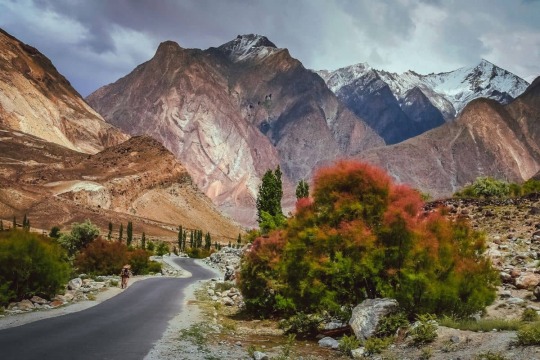
Introduction
Nestled amidst the majestic peaks of the Hindu Kush range lies the breathtaking Chitral Valley, a gem of natural beauty and cultural richness. Situated in the northwest of Pakistan, this enchanting valley holds a significant place in both geographical and cultural realms. In this article delve into depth where is Chitral valley situated.

Image by Canva
Geographical Location
Chitral Valley is located at approximately 35.8510° N latitude and 71.7869° E longitude. It is surrounded by the towering mountains of the Hindu Kush range and shares borders with Afghanistan to the north and west, Gilgit-Baltistan to the east, and the Khyber Pakhtunkhwa province to the south.
Chitral Valley within Pakistan
Within Pakistan, Chitral Valley is part of the Khyber Pakhtunkhwa province. It is situated at a considerable distance from major cities like Islamabad and Peshawar, providing it with a remote and pristine allure.
Topography and Landscape
The topography of Chitral Valley is characterized by rugged mountain ranges, including Tirich Mir, the highest peak in the Hindu Kush. Several rivers, including the Chitral River and its tributaries, traverse the valley, creating picturesque valleys and fertile plains.
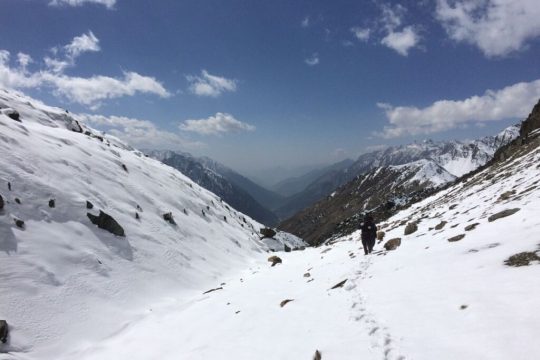
Image by Canva
Climate
Chitral Valley experiences diverse climatic conditions, with hot summers and cold winters. The region receives moderate to heavy snowfall during the winter months, while the summer season brings pleasant temperatures, making it an ideal destination for travelers.
Flora and Fauna
The valley boasts rich biodiversity, with a variety of flora and fauna inhabiting its diverse ecosystems. Endangered species such as the Marco Polo sheep and the snow leopard find sanctuary in the pristine wilderness of Chitral.
Cultural Significance
Chitral Valley is home to various indigenous communities, including the Kalash people, renowned for their unique culture and customs. Traditional festivals such as the Chilimjusht and Uchau showcase the vibrant heritage of the valley.
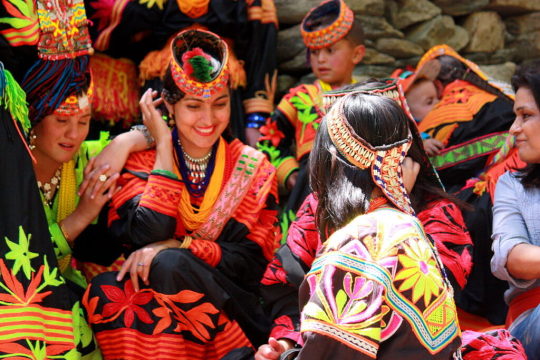
Image by Canva
Tourism in Chitral Valley
Tourism plays a vital role in the economy of Chitral Valley, attracting visitors with its stunning landscapes and cultural attractions. Adventure enthusiasts can indulge in activities like trekking, mountaineering, and river rafting amidst the breathtaking scenery.
Infrastructure and Accessibility
While Chitral Valley remains relatively remote, efforts have been made to improve infrastructure, including road networks and air travel options. The Lowari Tunnel provides year-round access to the valley, enhancing connectivity with the rest of the country.
Challenges and Conservation Efforts
Despite its natural beauty, Chitral Valley faces environmental threats such as deforestation and habitat loss. Conservation initiatives aim to preserve its pristine ecosystems while promoting sustainable development.
Economic Contributions
Agriculture and livestock rearing are the primary sources of livelihood for the inhabitants of Chitral Valley. Additionally, handicrafts and tourism contribute significantly to the local economy, providing employment opportunities for the residents.
Future Prospects
As Chitral Valley seeks to balance economic development with environmental conservation, sustainable development goals are prioritized. Efforts are underway to promote eco-tourism and preserve the valley's natural heritage for future generations.
https://youtu.be/IDeEG_ftGZk?si=D0Nlwh4bK1zztC18
Video by BrownBoyTravels YouTube Channel
Conclusion: Where is Chitral Valley Situated
In conclusion, Chitral Valley stands as a testament to the unparalleled beauty of Pakistan's northern regions. Its majestic landscapes, rich biodiversity, and vibrant culture make it a must-visit destination for travelers seeking adventure and tranquility amidst nature's splendor.
FAQs
1. Is Chitral Valley safe for tourists?
Yes, Chitral Valley is generally safe for tourists, with welcoming locals and stunning landscapes. However, it's advisable to respect local customs and travel advisories.
2. What is the best time to visit Chitral Valley?
The best time to visit Chitral Valley is during the summer months (May to September) when the weather is pleasant, and outdoor activities are in full swing.
3. Are there accommodations available in Chitral Valley?
Yes, Chitral Valley offers a range of accommodations, including hotels, guesthouses, and camping facilities, catering to various budgets and preferences.
4. What are some must-visit attractions in Chitral Valley?
Some must-visit attractions in Chitral Valley include Shandur Pass, Kalash Valley, and the Chitral Gol National Park, known for their scenic beauty and cultural significance.
5. How can I reach Chitral Valley from Islamabad?
The most convenient way to reach Chitral Valley from Islamabad is by air, with regular flights operating to Chitral Airport. Alternatively, you can travel by road via the picturesque Lowari Pass.
-
Read the full article
#ArethereaccommodationsavailableinChitralValley#chitral#chitralvalley#destination#explore#hiking#HowcanIreachChitralValleyfromIslamabad#IsChitralValleysafefortourists#pakistan#places#tourism#travel#Whataresomemust-visitattractionsinChitralValley#WhatisthebesttimetovisitChitralValley#whereischitralvalleysituated
0 notes
Text
High Altitude Thrills: The Shandur Polo Festival
Shandur Polo Festival: Celebrating the Sport of Kings
The Shandur Polo Festival is an annual event held in the Shandur Pass, located in the northern region of Pakistan. This festival is renowned for being the highest polo ground in the world, situated at an altitude of approximately 3,700 meters above sea level. Polo teams from different regions of Pakistan, particularly from Gilgit-Baltistan…
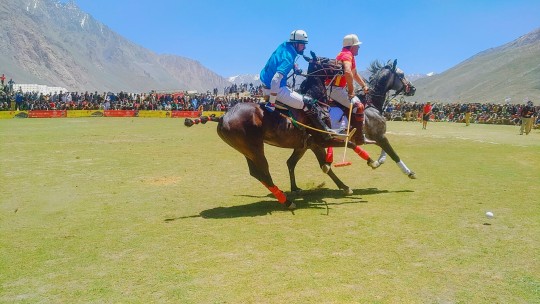
View On WordPress
#adventure#adventure enthusiasts#altitude#best tour company in Islamabad#camping#Celebration#Chitral#Chitral tour packages#Community#Competitions#Cultural exchange#cultural performances#dance#Development#diversity#Entertainment#Excitement#Exploration#Festivities#Free Polo#Friendship#Gilgit-Baltistan#Handicrafts#heritage#highest polo ground#Himalayas#horse riding#Hospitality#Islamabad to Chitral tour packages#Islamabad to shandur tour packages
0 notes
Text
420 All Month: Citral Glue
420 All Month! Today is Citral Glue.
HybridModerately High THC (22% – 26%)Flower
Sometimes I sleuth around about a strain that catches my attention, just to see what I can learn, and not for any particular reason related to either getting high or selling cannabis. Sometimes I’m just intensely curious, and I need to satiate myself with knowledge, or at least the act of trying to acquire that knowledge. Call it any variation on…
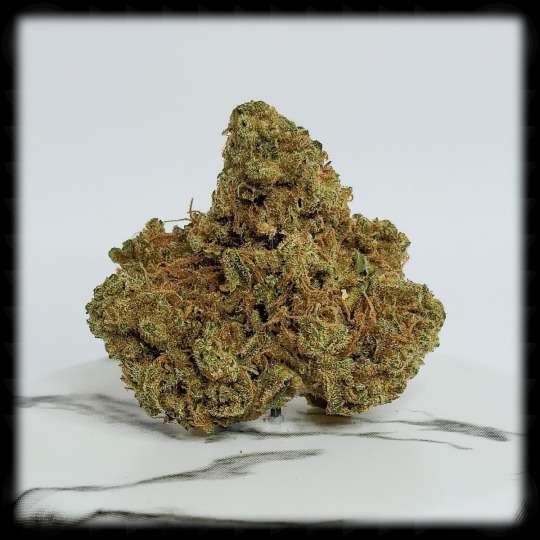
View On WordPress
#420#Anxiety Reduction#At Home#Bright Green#Brilliant Buds#Butter#Calm#cannabis#Cheese#Chitral#Chitral Kush#Citral Glue#Citrus#Creative#Crumbly#Deep Googling#Dry#Euphoric#Evening#Flower#Fluffy#Fuzzy#Herbal#Hindu Kush#Hybrid#Irregularly-shaped Nugs#Large Nugs#Light#Moderately High THC#Orange Hairs
0 notes
Text
The Enchanting Tales of the top 10 coldest places in Pakistan

As the winter chill sets in and people bundle up in their warmest coats, spare a thought for those living in the coldest places of Pakistan. Nestled amidst towering mountains and icy winds, these regions experience extreme temperatures that most can only imagine. From the frosty peaks of Skardu to the freezing valleys of Hunza, these areas are not for the faint-hearted. In this article, we will explore the coldest places in Pakistan, revealing their breathtaking beauty and unforgiving climate.
Step into a land where winters are more than just snowflakes gently falling from the sky, they're bone-chilling gusts that freeze your soul. Welcome to Pakistan's coldest corners - places that defy ordinary notions of coldness with their mind-numbing temperatures and harsh conditions. Here, survival is an art form mastered by resilient locals who have learned to embrace winter's icy grip rather than run from it. Join us as we embark on an adventure through these coldest places in Pakistan.
Here are the top 10 coldest places in Pakistan
- Ziarat Baluchistan
- Skardu Gilgit Baltistan
- Hunza Valley Gilgit Baltistan
- Chitral Khyber Pakhtunkhwa
- Kalat Baluchistan
- Swat Valley Khyber Pakhtunkhwa
- Malam Jabba Gilgit Baltistan
- Rawalakot Azad Kashmir
- Quetta Baluchistan
- Murree Punjab
Ziarat Baluchistan
Nestled amid the snow-capped peaks of Baluchistan in Pakistan lies Ziarat, a hidden gem that transforms into a winter wonderland. As the coldest city in Pakistan, Ziarat offers an enchanting escape from the bustling city life. The mesmerizing beauty of this winter paradise is unparalleled.
This charming hill station known as the Juniper Forest offers an enchanting retreat from the scorching heat of the plains during summer and becomes a magical paradise in winter. With temperatures dropping to sub-zero levels, Ziarat dons an ethereal beauty as every nook and cranny is blanketed in pure white snow.
Top 10 most beautiful places to visit in Pakistan
What sets Ziarat apart from other winter destinations is its unique blend of scenic landscapes and cultural attractions. For those seeking solace, Ziarat Residency, where Quaid-e-Azam Muhammad Ali Jinnah spent his last days, offers tranquility like no other place, surrounded by snow-covered junipers.
Ziarat boasts a rich history that adds depth to any visit. Dating back to British colonial times, this town served as a preferred summer retreat for high-ranking officials who sought respite from the oppressive heat elsewhere.
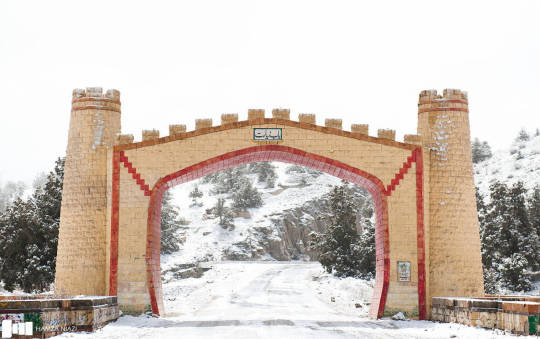
Ziarat City Entrance
Skardu Gilgit Baltistan
Wrapped in a pristine white blanket of snow, Skardu transforms into a winter wonderland that beckons both adventurers and nature enthusiasts. Nestled amidst the towering peaks of Karakoram and the Himalayas, this picturesque town experiences freezing winters like no other place in Pakistan. The unique geographical location of Skardu, with its high mountain ranges and deep valleys, makes it one of the coldest places in Pakistan.
Skardu valley, Gilgit Baltistan Tour
The freezing winters of Skardu bring forth an ethereal beauty that captivates the senses. As gusts of wind whip through the narrow valleys, they carry tiny ice crystals that shimmer in the sunlight like magical diamonds. The frozen rivers and lakes reflect the muted colors of the surrounding landscape, creating a surreal mirror-like effect. The magnificent peaks stand tall and majestic against clear blue skies, their tops glistening with pristine white snow. Experiencing the freezing winters of Skardu is not for the faint-hearted but is undoubtedly an adventure worth undertaking for those seeking serenity amid nature's icy grip.

Shangrila resort Skardu Valley
Hunza Valley Gilgit Baltistan
Nestled in the picturesque valleys of Northern Pakistan, the Hunza Valley is a winter wonderland that beckons travelers seeking an adventure amidst icy landscapes. Renowned as one of the coldest places in Pakistan, this hidden gem offers stunning views of snow-covered mountains and crystal-clear lakes. With its towering snow-capped peaks, frozen rivers and lakes, and pristine white meadows, this region transforms into a magical spectacle during winter. As you step into this frozen paradise, let yourself be captivated by the breathtaking beauty in every direction.
9 Days Hunza Valley, Pakistan Tour
The Hunza Valley is renowned for its stunning glaciers, showcasing nature's mesmerizing talent for sculpting ice. These colossal ice formations create a surreal atmosphere as they glitter under the sunlight and reflect hues of blue and turquoise. Please take a moment to stand in awe before these marvels of nature; feel the chill in the air as you witness the silent power of these ancient glaciers slowly shaping the land around them. This section on the icy landscapes of Hunza Valley delves into an enchanting realm where ice transforms ordinary scenery into extraordinary vistas.
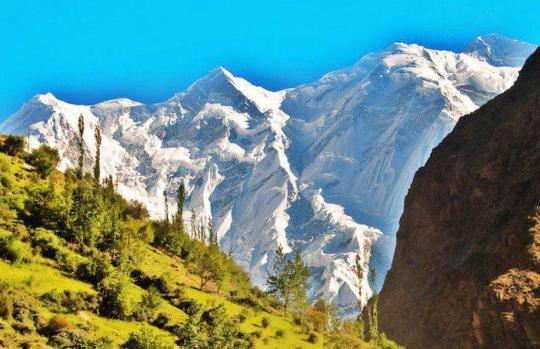
Rakaposhi peak (7788 M)Hunza Pakistan
Chitral Khyber Pakhtunkhwa
Chitral is nestled among the stunning Hindukush mountain range and is often hailed as one of the coldest places in Pakistan. This mesmerizing region boasts breathtaking landscapes covered in blankets of pristine snow during the winter months. Picture yourself surrounded by majestic peaks, snow-capped trees, and frozen rivers; it's like stepping into a real-life painting.
What sets Chitral apart from other cold destinations is its rich cultural heritage. The warmth and hospitality of the local people provide a stark contrast to the chilly temperatures. Embrace this opportunity to engage with the Kalash tribe, known for their unique traditions and vibrant festivals. Immerse yourself in their folklore, music, dance, and handmade crafts – truly an experience unlike any other.
So, pack your warmest clothes and get ready to explore one of the coldest places in Pakistan—Chitral, a haven where nature and culture harmonize amidst snow-clad landscapes that will undoubtedly leave you breathless.

Kalash People of Chitral Valley
Kalat Baluchistan
As winter descends upon the rugged region of Kalat, a unique and awe-inspiring spectacle unfolds. Nestled in the province of Balochistan, this town is considered one of the coldest places in Pakistan. The frigid winds blow relentlessly across its barren landscapes, transforming it into a winter wonderland. But what truly sets Kalat apart is not just its freezing temperatures, but the stoic resilience and adaptability of its people.
Top 10 beautiful places to visit in Islamabad
Kalat's residents have mastered the art of surviving in these extreme conditions. From wearing layers upon layers of clothing to lighting bonfires throughout their homes, they have developed ingenious ways to battle against Mother Nature's icy grip. Despite the hardships, there is a unique sense of camaraderie that emerges during these freezing months. Neighbors come together with warm cups of tea and comforting smiles, sharing stories and laughter as they navigate through this frosty ordeal.

Kalat Balochistan, Pakistan
Swat Khyber Pakhtunkhwa
Nestled in the mesmerizing mountains of Khyber Pakhtunkhwa, Swat Valley transforms into a true winter fairytale once the temperatures drop. As one of the coldest places in Pakistan, this picturesque region captivates visitors with its pristine snow-covered landscapes and breathtaking vistas. From glistening frozen waterfalls to charming wooden cottages dusted with snow, every corner of Swat Valley exudes a magical aura during the winter months.
But Swat Valley's winter charm is not just limited to outdoor excitement; it also has a cultural allure. The local people are known for their hospitality and warmth, welcoming visitors with open arms even during the coldest months. With traditional festivities, tourists get a chance to immerse themselves in the rich culture and traditions of this picturesque region. Exploring ancient Buddhist sites like Mingora's Saidu Stupa or taking a peaceful walk through dense forests covered in snow provide opportunities for both adventure seekers and history buffs alike.
4 Days Islamabad Swat Kalam Valley Tour
So, pack your warmest clothes and brace yourself for an unforgettable journey into Swat Valley - Pakistan's very own winter fairyland. Immerse yourself in breathtaking landscapes, embark on thrilling adventures, and witness cultural traditions that have stood strong amidst changing times. This hidden gem promises an experience that will leave you spellbound long after you say goodbye to its snowy wonderland.

Swat Valley KPK
Malam Jabba Khyber Pakhtunkhwa
Malam Jabba, nestled in the heart of the Swat Valley, is not only a popular ski resort but also one of the coldest places in Pakistan. Surrounded by awe-inspiring mountains and captivating landscapes, this frozen paradise offers a unique winter experience. What sets Malam Jabba apart from other cold destinations in Pakistan is its historical significance with ancient Buddhist stupas and monasteries that are spread across the resort. These remnants of archaeological sites provide glimpses into a rich past, and visitors to Malam Jabba can immerse themselves in natural beauty and cultural exploration.
Things to know about Pakistan before you visit this beautiful land
While many visit Malam Jabba for its world-class ski slopes, there's so much more to discover beyond the adrenaline rush on the snow-covered peaks. Nature enthusiasts will find solace in exploring nearby trails that lead to hidden valleys and pristine waterfalls, creating an unparalleled sense of tranquility amidst this frozen wonderland. Furthermore, local hospitality adds a charming touch to your experience as you warm up with steaming cups of kahwa (traditional tea) while savoring traditional delicacies at local cafes offering authentic Pakistani cuisine. So, if you're looking for an adventurous winter getaway that combines nature's splendor with cultural immersion, Malam Jabba should be at the top of your travel list.

Malam Jabba Swat Pakistan
Rawalakot Azad Kashmir
Located in the heart of Azad Kashmir, Rawalakot is a charming city that boasts unmatched natural beauty and tranquility. Often referred to as Paradise on Earth, this picturesque destination mesmerizes visitors with its snow-capped mountains, lush green valleys, and crystal-clear lakes. With an average elevation of 5,400 feet above sea level, it remains one of the coldest places in Pakistan throughout the year.
In addition to its outdoor activities, Rawalakot Azad Kashmir also boasts a rich cultural heritage that avid travelers can explore. The town is renowned for its traditional wooden architecture, which adds a unique charm to every corner. Visitors can delve into local history by visiting ancient temples and shrines, or immerse themselves in art and culture at various museums and galleries showcasing indigenous artwork. As the coldest city in Pakistan, Rawalakot Azad Kashmir promises an unforgettable winter retreat that combines nature's magnificence with cultural immersion.

Banjosa Lake Rawalakot Azad Kashmir
Quetta Baluchistan
Quetta considered the coldest city in Pakistan, is notorious for its bone-chilling temperatures. Nestled amidst the picturesque mountains of Baluchistan, it stands as a testament to the harsh winters that sweep across Pakistan. With average temperatures dropping below freezing point and sometimes even reaching -18 degrees Celsius, Quetta takes great pride in being one of the coldest places in Pakistan.
But there is more to Quetta's chilling temperature than meets the eye. While it may deter some from venturing outdoors, for others, it offers unique opportunities for thrilling adventure and exploration. The frozen lakes and rivers become playgrounds for ice skating enthusiasts looking to glide gracefully on their frozen surfaces.
Whether one seeks adventure or wishes to experience an intimate bond with nature and its people, Quetta's chilling temperature serves as both a challenge and an invitation—a chance to embrace the frozen beauty of this remarkable city while discovering new depths of resilience within ourselves.
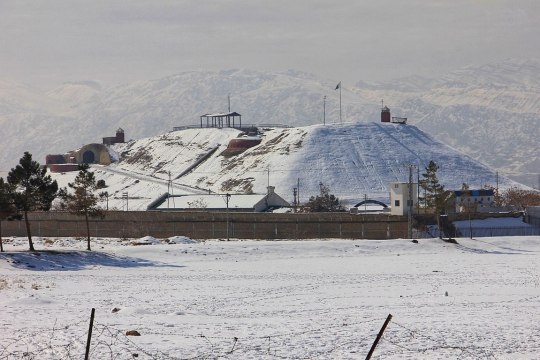
Quetta Fort Mirri
Muree Punjab
Nestled in the snow-capped peaks of the Pir Panjal Range, lies the enchanting hill station of Murree. Known for its captivating beauty and invigorating climate, this picturesque destination has earned its reputation as one of the coldest places in Pakistan. As winter blankets this picturesque retreat, it transforms into a wonderland that captivates all who venture there. Every turn offers breathtaking views of rolling hills blanketed in pristine white snow. The serenity that envelops Murree in winter is unlike any other, offering visitors a chance to pause and reconnect with nature.
3 Days Murree Tour Package
Beyond its scenic beauty, Murree also holds a rich history that adds another layer of appeal to its winter charm. Established during British colonial rule as a summer retreat for officials seeking respite from the scorching heat of the plains, it has retained much of its old-world charm and elegance. Colonial-era buildings dotting its streets provide glimpses into the past while adding an air of nostalgia to this serene winter escape.
While many flock to Murree for its tranquil atmosphere and stunning landscapes, it also offers many activities for thrill-seekers and adventure enthusiasts. From skiing down, powdery slopes to embarking on invigorating treks through snow-laden trails, there is no shortage of excitement for those craving outdoor adventures amidst the winter stillness.
The coldest places in Pakistan offer a unique and challenging winter experience like no other. Whether it be Skardu's freezing temperatures or Murree's heavy snowfall, each destination has its charm and attractions for adventurous individuals seeking a thrilling winter getaway. However, it is important to remember that visiting these areas requires proper preparation and caution due to the extreme conditions. So, if you're ready to embrace the cold and embark on an unforgettable journey, pack your warmest clothes and gear up for the adventure of a lifetime in the top 10 coldest places in Pakistan.

Muree Pakistan
Read the full article
#Chitral#Hunza#Kalat#MalamJabba#MureePunjab#QuettaBaluchistan#RawalakotAzadKashmir#Skardu#Swat#ZiaratBalochistan
0 notes
Text
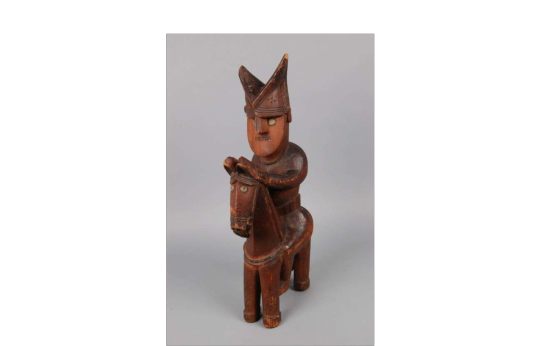
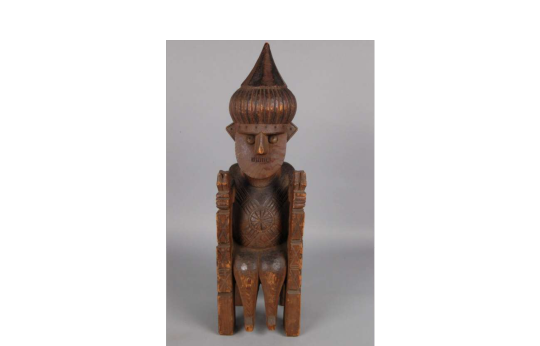
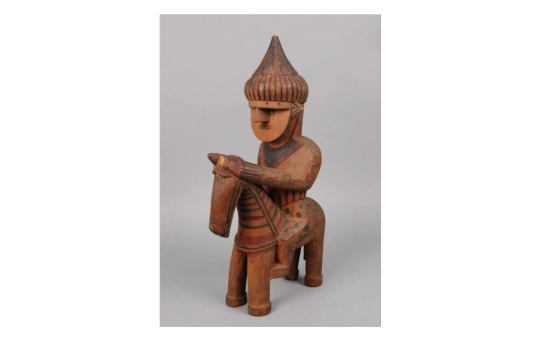
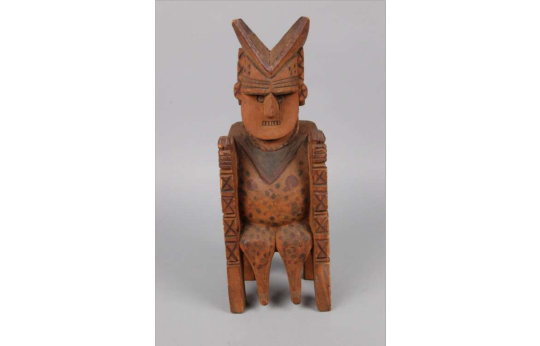
Gandau: Funerary Sculptures of the Kalasha
Chitral District, Pakistan
1895; 1915-1916
Source: The British Museum
"Gandaus are life-sized male and female effigies carved from wood (usually deodar) by the Kalasha people in Pakistan and, formerly, by the Nuristani people in Afghanistan. They are often intricately carved, painted and draped with items of clothing. Considered to be imbued with the spirit of the deceased, the figures are placed near coffins. Gandaus are traditionally carved by the Kalash people in Chitral, Pakistan. These figures are often carved from one piece of wood and take the form of the deceased. They are usually erected over the grave by the son of the individual who has died."
0 notes
Text
A social worker, an economist, and the legacy of Pakistan’s student movement of the 1950s
Something I wrote about my aunt who recently passed away, the economist Eric Rahim, and their decades-old linkages to progressive politics, and the ongoing legacy of the 1950s student movement #DSF my father led
OBITUARY: The legacy of a decades-old connection between social worker Shahida Haroon (1937-2023) and economist Eric Rahim (1928-2023) endures through the ongoing struggle for student rights, economic justice and democracy in Pakistan
Demands Day at D.H. Science College, 07 Jan. 1953, Eric Rahim, Shahida Haroon Saad. Collage by Aekta Kapoor/Sapan News
PERSONAL POLITICAL
By Beena Sarwar / Sapan…
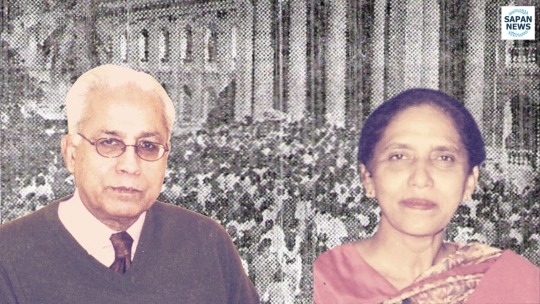
View On WordPress
#chitral#dr ghalib#Dr M Sarwar#DSF#Education#Eric Rahim#Marx#Pakistan#shahida haroon#solas#Student politics#student unions
0 notes
Photo
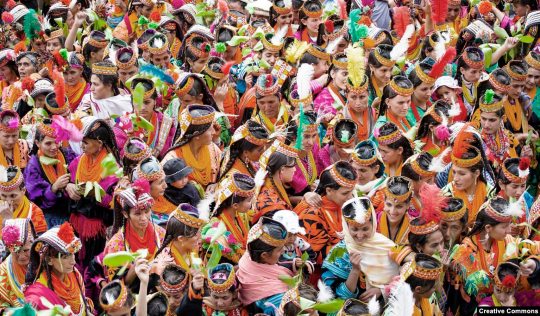
Chilam Joshi
Bumboret, Chitral, Pakistan
Tariq Sulemani
32 notes
·
View notes
Text
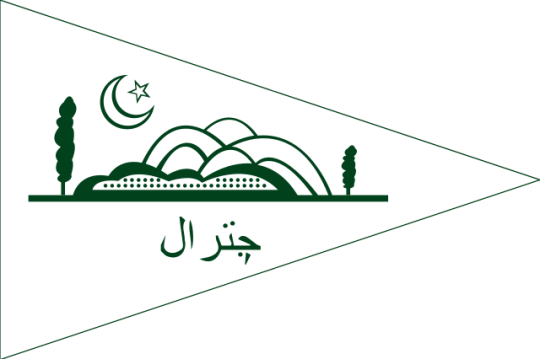
Flag of the Princely state of Chitral (1885-1947)
#chitral#princely state of chitral#khyber pakhtunkhwa#Pakistan#north west frontier province#own post
6 notes
·
View notes
Text

feel like pure shit just want her xx
#ignore the stupid southpakistani yt videos its called khalli!!! or laghman!!#its so. winter home childhood etc etc#lettos says#chitral#currymunching
4 notes
·
View notes
Video
Chitral is situated on the Chitral River in northern Khyber Pakhtunkhwa, Pakistan.
Contact us Right Now for checking such amazing point and explore the globe with 𝐄𝟐𝐄 𝐓𝐫𝐚𝐯𝐞𝐥 𝐀𝐧𝐝 𝐓𝐨𝐮𝐫.
#e2e#e2etravel#e2e travel and tour#e2e travel & tour#explore globe with e2e travel#explore pakistan#explore the globe#explore pak#e2e explore the globe#chitral
0 notes
Text

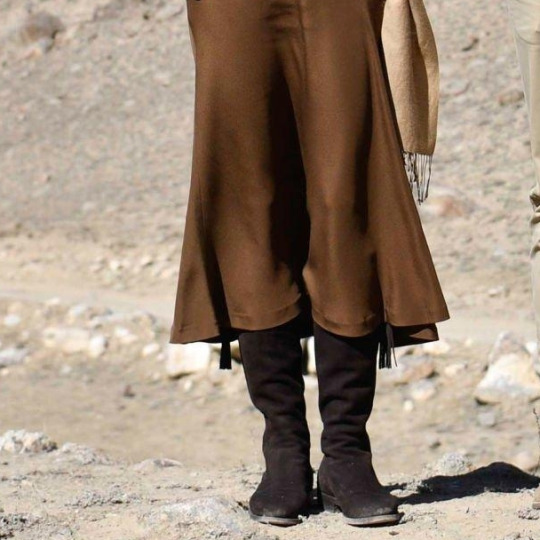
CATHERINE'S STYLE FILES - 2019
16 OCTOBER 2019 || The Duchess of Cambridge and Prince William spent their third day on tour in the Chitral District of Khyber-Pakhunkwa Province of Pakistan visiting the Chiatibo glacier in the Hindu Kush mountain range and visited the region's Kalash community.
#catherines style files#style files 2019#pakistan tour 19#day 3 pakistan tour 19#chitral district pakistan visit 19#chiatibo glacier 19#kalash community chitral 19#16.10.2019#really wild clothing.#catherine in missoma.#missoma.#hobbs london.#hobbs.#mint velvet.#catherine wearing mint velvet.#gold zenyu chandelier hoop earrings#gold zenyu hoop earrings.#zenyu hoop earrings.#zenyu chandelier hoop earrings.#british royal family#british royals#brf#royalty#kate middleton#royals#duchess of cambridge#royal#princess of wales#princess catherine#gold zenyu earrings.
23 notes
·
View notes
